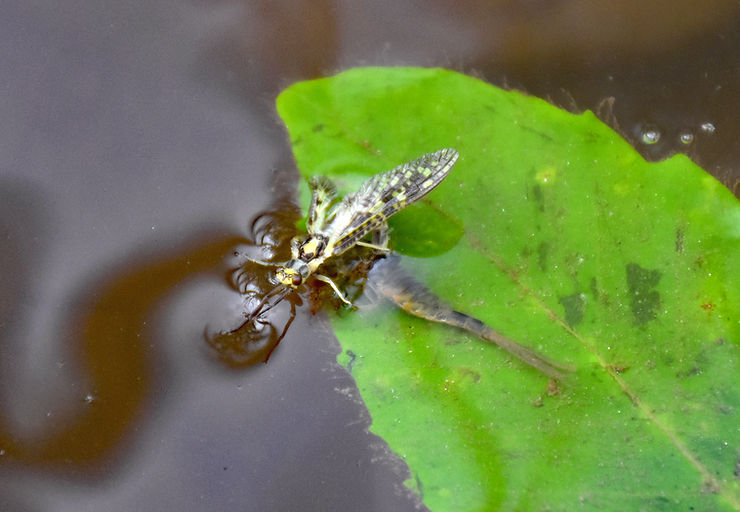Mayfly Life Cycle: From Nymph to Dun to Spinner

A few years ago, I was fortunate to hit a solid hatch of Green Drakes on First Fork Sinnemahoning Creek. There weren’t a ton of bugs in the air, but enough to get the trout looking up. If I put an imitation over a feeding fish, it resulted in a catch more often than not. The most unique part of the spectacle, though, was being able to observe the drakes actually metamorphosing on the water’s surface, shedding their exoskeletons as they transitioned into duns. It got me thinking about the whole life cycle of mayflies and their amazing journey.
There are over 3,000 species of mayflies worldwide. The term mayfly refers to all species in the order Ephemeroptera but was originally associated with one particular species in the UK, the Ephemera danica. Supposedly, even now, if you refer to any species other than the Ephemera danica as a mayfly, you’re likely to end up as trout food in some parts of England.
Ephemera danica once emerged primarily in the month of May, but changes from the Julian to the Gregorian calendar in the 1500s meant that the fly now appeared into June. Of course, we see one species of mayfly or another emerge almost year-round on some waters. However, the bulk of the action takes place from mid-April until mid-June here in northeastern U.S. streams and rivers.
Today, the term Mayfly is used to describe flies with upright wings, as opposed to caddis and stoneflies which have downwings. Depending on where you live in the world, mayflies can also be called shadflies, fishflies, dayflies, or any other moniker, but they all refer to the same thing.

The Nymph
In nature, complete metamorphosis means an insect transforms from egg to larva to pupa to adult. The life cycle of a mayfly lacks an intermediate pupal stage. The nymph itself is a larva that resembles the adult form.
Depending on species, some mayfly nymphs live for years in the substrate or detritus of a stream or river before emerging. And while some species are known as “clingers,” such as March Browns because they cling to the undersides of rocks and debris, other species, such as Green Drakes, are burrowers that will dig tubular burrows into the stream bottom through which they filter organic matter for feeding.
When the time is right for a particular species to hatch, air and gas collects under their exoskeleton which helps them make their way toward the surface. As they emerge (hence we call the fly pattern that imitates this stage an “Emerger”), their exoskeleton splits along the back. As they’re molting, mayflies don’t breathe, and many of them perish before they reach the surface.

The Dun (Subimago)
Either on their way up or once they reach the surface, mayfly duns break free of their exoskeletons. Their wings are lined with tiny hairs that help them shed water, but they cannot fly until the veins in their wings fill with fluid. The Dun has no developed mouth parts and survives on energy reserves gathered during its nymphal stage.
During the Green Drake (Ephemera guttulata, a.k.a. Eastern Green Drake) hatch mentioned above, I was able to witness the duns breaking free of their exoskeletons. The nymphs appeared on the water’s surface surrounded by an air bubble that held them in the film. I had the unique experience of watching these drakes pull free of their nymphal shucks. It was also amazing how many of them weren’t able to free completely and struggled on the surface, and also the number of insects that ended up with damaged wings from the process.
The trout thought they were neat, too – and easy targets. I can see why “cripple” versions of certain imitations work extremely well. When an emerging mayfly ends up crippled on the surface, its struggling attempt at flight is like ringing a dinner bell for the fish.

The Spinner (Imago)
After hatching, the Dun isn’t yet sexually mature. In order to mate, it must undergo another molting into a Spinner. This phenomenon is unique in the insect world. No other species has two stages of winged adulthood. After hatching, the duns cling to streamside vegetation where they molt and become sexually mature spinners.
Females release a scent that attracts males. You can recognize an adult spinner by its antennae and seemingly over-sized eyes. Spinners are also slightly smaller than the duns with longer and more slender bodies. When hatch-matching, this equates to approximately one hook size smaller. So if a Green Drake dun is a size 8, then its spinner version, called a Coffin Fly, will typically be represented by a size 10.
Once mature, spinners swarm above the water, mating in flight. Spinners usually die within a few hours of mating. The females deposit their eggs in a variety of ways, some dropping them from above while others fall to the surface, and yet others dive-bomb into the water – we often refer to this whole process as the “spinner fall.”
Egg-laying complete, the spinners end up spent on the water’s surface. Meanwhile, the eggs drop to the stream bottom where they stick to various rocks, sticks, and other debris. Depending on the species, these eggs will hatch within a few days or a few weeks into nymphs, and the process will start all over again.

Did You Enjoy Reading This Article About The Mayfly Life Cycle?
Stay up to date with the Dark Skies Fly Fishing monthly newsletter for free and receive the latest posts in fly fishing news, tricks, tips, and techniques, stream reports, as well as updates on new flies added to the Online Store and exclusive discounts!
Sign Up Now